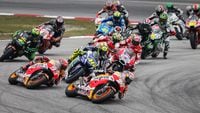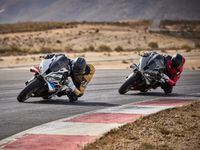Motorcycle road racing has seen a big uptick in recent years. Both MotoGP and WSBK have had an influx of both talent and drama, and the MotoAmerica series has picked up where the AMA series left off with racing in the States. Understanding the different classes and races can be confusing, but that's what we're here for.
MotoGP is the premiere form of motorcycle road racing in the world, and it carries two main distinctions. First, it attracts the best riders in the entire world. It's the main stage. The big show. To pilot a MotoGP bike is to be regarded among the best who've ever graced two wheels, even if you're a backmarker.
Second, the bikes are all completely custom built prototype machines. This means that, while they're used for R&D purposes, they share very little if anything with the bikes that carry the same logos on showroom floors. I know, I was confused when people talked about Marquez's Honda eating rear tires and making too much brute power when I first started watching racing as well. Because yes, the current CBR is a dog.
Within MotoGP, there are three classes which, luckily, follow along roughly with the classes from the other series. MotoGP, the top level series, uses 1,000 cc bikes that are limited to four cylinders and a maximum bore of 81 mm.
Instead of each manufacturer making their own Moto 2 engine, those bikes all feature the same 600 cc four stroke, which is a Honda CBR600RR motor tuned by a company named ExternPro.
The Moto 3 bikes are all 250 cc, single cylinder machines. And while extremely close in performance, this “baby class” is a hotly contested engineering competition for the manufacturers. Oddly, the cost of Moto3 is reportedly 2-3 times as expensive as running in the Moto2 class.
While MotoGP is intended to be a pure showcase of what brands can do with unlimited resources, it’s WorldSBK that actually gives us something we can learn from. Unlike the prototypes used in GP, the WSBK machines are all based on those found in your local dealership.
Again, the bikes are split into the categories of the bikes we have available for purchase, 600 cc and 1,000 cc, but this series is split once more. Both categories are split between “Superstock” and regular “supersport,” or “superbike” to differentiate between how much aftermarket support they can receive.
So, at the top level, we have Superbike and Superstock 1000. The Superbikes can have between 750 cc and 1,200 cc, depending on the number of cylinders, and receive modifications to the engine’s parts, management system, exhaust, suspension, and brakes. At this level, they also get special tires from Pirelli, which is they develop their production tires.
Meanwhile, the Superstock 1000 bikes are kept as close to stock as possible. Teams are only getting to swap for better suspension and exhaust, and then add race plastics and make small modifications for ergonomics.
Then we have Supersport and Superstock, the 600 cc classes, both of which are allowed engines between 400 cc and 750 cc, depending on the number of cylinders. As with the literbikes, the Supersports receiving a larger smattering of upgrades and options and the Superstock bikes only get suspension and exhaust modifications.
With the absence of AMA Pro Racing, the U.S. presence in any form of international road racing has gone by the wayside. MotoAmerica, a new series with Wayne Rainey at the helm, seeks to bring road racing back to the states and in a format that can throw more Americans onto the world stage.
With this in mind, the classes are set up identically to WorldSBK, so that a rider who performs well or who a team thinks can be successful can make the jump easily.
MotoAmerica hasn’t quite gotten it’s feet off the ground yet, and their TV deal with BeIN Sports was sorted just one day before the first race of the season, held at COTA during the MotoGP round several weeks back.
But, they’ve attracted some incredible riders with the likes of Josh Hayes, Cameron Beaubier, Roger Hayden, Corey Alexander, Jake Gagne, privateer Benny Solis, and a kid who will hopefully be the next American phenom in Joe Roberts.
MotoGP is often the easiest form of road racing to get into and, as with most sports, it’s easy to only focus on the premiere class and look at the rest like lesser or diluted versions. But motorcycle racing is different. Watching a Moto 2 rider back it in to corners or Moto 3 riders drafting off each other brings it’s own form of excitement.
And, like MotoGP, it’s often the riders’ personalities, performance, and the narratives between them and other riders that make it interesting. And that exists everywhere if you look.











/cloudfront-us-east-1.images.arcpublishing.com/octane/PJWDCLJOUBHMFIKXBF4T5MFFNI.jpg)
/cloudfront-us-east-1.images.arcpublishing.com/octane/HR5TX3KGQ5BMTISR4ABEKM7KQM.jpg)
/cloudfront-us-east-1.images.arcpublishing.com/octane/GPZBJ2S3ARAI3AZMV4R2Z2YM3Q.jpg)
/cloudfront-us-east-1.images.arcpublishing.com/octane/5CR2ZRKMIZAYNAZGI2VZMU2ZOI.jpg)
/cloudfront-us-east-1.images.arcpublishing.com/octane/AUE3NFVRRZDSBIDVUGIYIDQNUI.jpg)
/cloudfront-us-east-1.images.arcpublishing.com/octane/LYR62CH2WNBMHJJVXVATZHOUE4.jpg)
/cloudfront-us-east-1.images.arcpublishing.com/octane/RBCTRGBQYBDK7A6XPG3HKPS7ZQ.jpg)
/cloudfront-us-east-1.images.arcpublishing.com/octane/MQXQRYMZVBCWJIRYP3HEN3SHVE.jpg)
/cloudfront-us-east-1.images.arcpublishing.com/octane/TSPODNNEWRDSVJGUCNQTDG4ADI.jpg)
/cloudfront-us-east-1.images.arcpublishing.com/octane/X5TB7BDV4BA2RPSY54ZGK27RP4.jpg)
/cloudfront-us-east-1.images.arcpublishing.com/octane/REUHOJXRDBGZ5IHBYZCCBCISPA.jpg)
/cloudfront-us-east-1.images.arcpublishing.com/octane/52LGJTCKBFEHDF7S7H4CVUIMGM.jpg)
/cloudfront-us-east-1.images.arcpublishing.com/octane/YMWAIPIPSJAOXOU3QMJMGH37OM.jpg)


/cloudfront-us-east-1.images.arcpublishing.com/octane/EJ6KZRGAYBCVXNL2PJXL37UVWQ.jpg)
/cloudfront-us-east-1.images.arcpublishing.com/octane/AAN4TI76M5H5JMUVEIGASWXBDU.jpg)
/cloudfront-us-east-1.images.arcpublishing.com/octane/P3RXD2UCPFF37CMB7CHPVKXORY.jpg)
/cloudfront-us-east-1.images.arcpublishing.com/octane/VZEG2EJI2RDFZNHLRZMU56MD3Q.jpg)
/cloudfront-us-east-1.images.arcpublishing.com/octane/GVJQO5FFOFBWNGODOBRB4FBAW4.jpg)
/cloudfront-us-east-1.images.arcpublishing.com/octane/BIVAK2SFIBDJJM25E7I5VU2FJE.jpg)
/cloudfront-us-east-1.images.arcpublishing.com/octane/CH5VX52UG5CFHOVH5A6UYEFWWA.jpg)
/cloudfront-us-east-1.images.arcpublishing.com/octane/ZVGJNGZRU5C33N7KN23BBFKSC4.jpg)


/cloudfront-us-east-1.images.arcpublishing.com/octane/CZ5OM3E43ZEXJHY7LCYXCHLIKI.jpg)
/cloudfront-us-east-1.images.arcpublishing.com/octane/DF5T4K5KPZFJXFCTGPYR77PKJM.jpg)
/cloudfront-us-east-1.images.arcpublishing.com/octane/RMCT2KVQBJHBZMRTSLOVPMOILU.jpg)